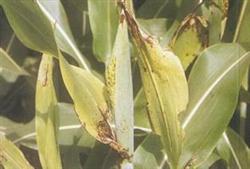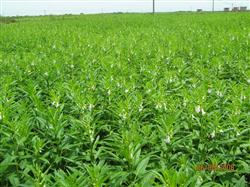Sorghum leaf spot disease

The symptoms are also known as spot disease. The disease can occur in all parts of the plant, mainly harmful leaves. The plaque is irregular in shape, long to fusiform or semicircular in size, up to more than 1cm, yellowish brown to grayish brown, with reddish purple edges. The disease spot often starts at the edge or end of the leaf, and some occur on the leaf surface or the upper part of the ear, causing the flag leaf to fold. The expansion of the disease spot often fused into larger patches, and scattered or rows of small black spots could be seen on the dry leaf spots in the later stage, that is, the conidium of the pathogen. Seed glume infection produces similar symptoms. It occurred in Beijing, Shanxi, Inner Mongolia, Northeast and Southwest. The harm is becoming more and more serious. The pathogen Phyllosticta sorghina Sacc. It is called sorghum leaf spot mold, which belongs to the subphylum of semiknowns. Conidium black, subglobose, scattered on the leaf surface, protruding epidermis, the size of 64-194um. The conidia are oval, unicellular, colorless, 3.5 Mel 6 × 2.0 Mel 3.0 (um) in size. In addition to infecting sorghum, it can also infect millet, millet, paspalum, sugarcane, Sudan grass and so on. The pathogen of transmission and disease condition overwintered on the diseased body by conidia. In the following year, Beijing, Jilin and other places began to develop the disease in June, and the symptoms were obvious or epidemic from July to August. It is observed that the disease of early sowing field is more serious than that of late sowing field. There were differences in disease resistance among varieties. in the same field, the disease was more serious in Kang 7 and Shenza 5, but not in Kang 4. In 1994, Beijing Miyun and Yanqing planted hybrid sorghum Kang 7 and Shenza 5 with poor resistance to the disease. in addition, the climate of that year was special, there was no rain in June, the rainfall increased after July, and the rainfall 575mm reached 268mm in August, which was more than that of previous years, and the sunshine decreased obviously. From July to August, the air humidity was 78.7% Mel 79%, and the temperature was 0.5 ℃ higher than that of previous years. Caused the epidemic of leaf spot disease. In recent years, the damage of the disease has a rising trend, serious loss of production or harvest. Control methods (1) according to local conditions, select disease-resistant varieties suitable for local cultivation. When introducing new varieties, attention should be paid to combining agronomic characters with disease resistance to select new varieties with high quality, high yield and disease resistance which are suitable for the local area. (2) sowing at the right time should not be prematurely. (3) at the initial stage of the disease, 36% methyl thiophanate suspension or 50% carbendazim wettable powder 1500 times, 80% bengke wettable powder 600 times, 80% Dasheng M-45 wettable powder 600 times, 30% Lvyedan wettable powder 500 times 800 times.
- Prev

Sesame should not be planted continuously.
Planting sesame with early crops such as peas, rape and barley has a certain area in our region, which is a great advantage in sesame production. However, in terms of management, it is still in accordance with a set of management methods of summer sesame, so that the latent advantages of early stubble sesame can not be brought into full play, and the output is not very ideal. In order to give full play to its increase.
- Next

Chemical control of sorghum rust
Symptoms Sorghum rust begins to develop around heading. Red or purple to light brown spots were formed on the leaves, and then the spots expanded with the expansion of the pathogen, and oval raised urediospores were formed on the surface of the leaves. After cracking, brown powder, namely urediospores, was exposed. In the late stage, winter spores form in situ...
Related
- The first cup of black tea in spring, the flavor and history of tea gardens in Kenya, Africa
- The computer can not only choose potatoes, but also grow tea rice. AI will grow winter oolong tea champion.
- It is not only the inflated tea bitten by insects, but also engraved with the four seasons tea in Beipu.
- The Oriental Beauty Tea Festival in Zhuxian County takes the stage at the weekend to experience the plus-size feast of oil tea.
- & quot; Oriental Beauty Tea & Exploration of Emei in Hsinchu, the hometown of quot;
- The new variety of strawberry "Tainong 1" dessert is the first choice with mellow aroma. Crimson gorgeous
- History of Tea in Taiwan: from Wild Inner Mountain to Export Tea Garden
- Two types of Taiwan Oriental Beauty Black Tea won the British three-Star Award for Childhood Tea Xiang Zhang Jiaqi changed from pilot to champion tea maker.
- Banana species and varieties: the planting history of Taiwan Xianren banana and dwarf banana is long, is banana disease resistant?
- Coffee planting Technology: Qianjie Coffee from Seedling to harvesting

